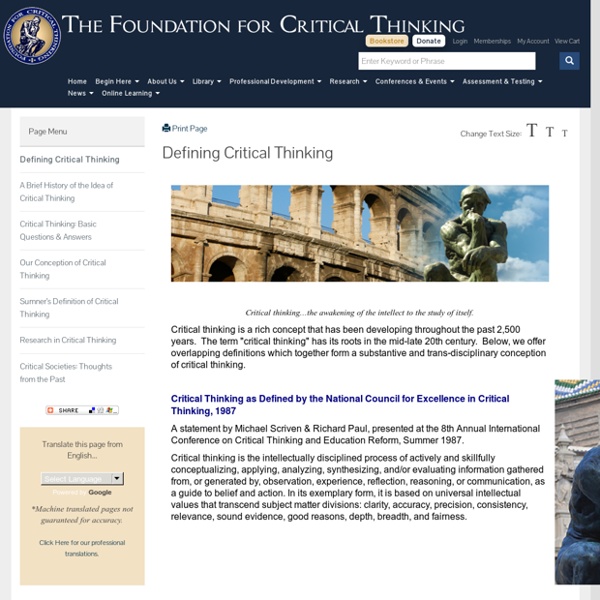Critical Thinking and Problem-solving
What is Critical Thinking? When examining the vast literature on critical thinking, various definitions of critical thinking emerge. Here are some samples:
Critical Thinking: Basic Questions & Answers
To think well is to impose discipline and restraint on our thinking-by means of intellectual standards — in order to raise our thinking to a level of "perfection" or quality that is not natural or likely in undisciplined, spontaneous thought. The dimension of critical thinking least understood is that of "intellectual standards." Most teachers were not taught how to assess thinking through standards; indeed, often the thinking of teachers themselves is very "undisciplined" and reflects a lack of internalized intellectual standards.
Types of Reasoning
Disciplines > Argument > Types of Reasoning Reasoning within an argument gives the rationale behind why one choice, for example should be selected over another. Types of reasoning include: Abduction: the process of creating explanatory hypotheses.
- Critical Thinking Model 1
To Analyze Thinking We Must Identify and Question its Elemental Structures Standard: Clarityunderstandable, the meaning can be grasped Could you elaborate further? Could you give me an example? Could you illustrate what you mean?
Critical thinking
Critical thinking is a type of clear, reasoned thinking. According to Beyer (1995) Critical thinking means making clear, reasoned judgements. While in the process of critical thinking, ideas should be reasoned and well thought out/judged.[1] The National Council for Excellence in Critical Thinking defines critical thinking as the intellectually disciplined process of actively and skillfully conceptualizing, applying, analyzing, synthesizing, and/or evaluating information gathered from, or generated by, observation, experience, reflection, reasoning, or communication, as a guide to belief and action.
Responsible thinking web sites
Critical Thinking sites: These sites discuss critical thinking and common errors in reasoning. The Critical Thinking Community While perhaps the most widely referenced site on critical thinking, the style of the above site is far too dry and academic for my taste. Wikipedia entries for logical fallacies and cognitive biases:
CERE12-13: Combined student wikis
Deep and Surface Learning: The Literature Tell me, I forget. Show me, I remember. Involve me, I understand. - Confucius
Semantic Research
Semantic Research, Inc. (commonly referred to as Semantic Research or simply Semantic, and not to be confused with Symantec), incorporated in 2001, is a privately held software company headquartered in San Diego, California. The company manufactures and sells software for creating, viewing, storing and sharing of knowledge structures.[1]
To think critically, you have to be both analytical and motivated
In a world where accusations of "fake news" are thrown around essentially at random, critical thinking would seem to be a must. But this is also a world where the Moon landings are viewed as a conspiracy and people voice serious doubts about the Earth's roundness. Critical thinking appears to be in short supply at a time we desperately need it. One of the proposed solutions to this issue is to incorporate more critical thinking into our education system.
Instructional or Learning Design
What is known as “sequencing” and organizing “epitomes” in Reigeluth's Elaboration theory, is commonly referred to as “chunking”—configuring large amounts of information into smaller units of information that are scaffolded (supportive structures) in order to accommodate memory and learning limitations. For example, “Instructional Design” is chunked or epitomized into analysis, design, development, Implementation, & evaluation. Developing instruction (Instructional Design) is divided into several theories and a model (at least on this site). Notice how we took a complex subject and chunked it into small, bite size pieces. Charles Reigeluth was a doctorate student of Merrill.
Debategraph
Debategraph is a web-based, collaborative idea visualization tool, focusing on complex public policy issues. It has been used by the White House,[1] the UK Foreign and Commonwealth Office,[2] the Amanpour series on CNN,[3] and The Independent newspaper[4] and was named as one of the Best Websites for Teaching and Learning by the American Association of School Librarians in 2010.[5] Debategraph is a social venture operating under a CC-BY-SA 3.0 license[citation needed]. History[edit] See also[edit]
How to improve your Critical Thinking skills: Interview with Dr. Gerald Nosich – Life Lessons
In this article I interview an expert on Critical Thinking, Dr. Gerald Nosich from the Foundation for Critical Thinking, who has been teaching Critical Thinking since 1977 to find out how we can improve our Critical Thinking skills. In this article you will learn: Let’s start at the beginning… Michael: What is Critical thinking? Dr.



